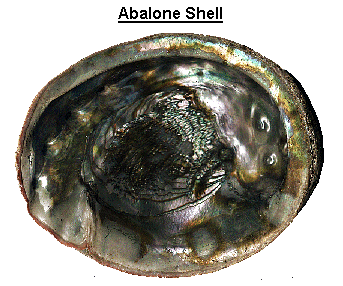Shells and Sea Shells
Sea shells are one of our most ancient decorations. Our prehistoric ancestors used to string them into necklaces or hang them from cords as pendants. People still use them this way today.
2 Minute Read
Sea shells are one of our most ancient decorations. Their earliest use was to string them into a necklace, or hang them from a cord as pendants. People still use them this way today.
We frequently find shells cut into hishi beads. This is a simple process that is preformed on beaches through out the world, but especially in the Philippines where most of our commercial hishi comes from. The shells are cut into squares and a hole drilled in the center. They are strung on a wire that is drawn tight. Then they are filed or ground into round shapes. A fine abrasive gives them their finish.
Hishi beads come in a wide variety of colors and sizes. They are very inexpensive and the gemologist is not likely to be asked to identify them.
A number of shells are cut into cabochons or used for inlay. Of these, operculum is unique in that it produces an eye like cabochon.
Several types of shells have useful mother of pearl interiors. (Mother of Pearl is the iridescent layer found on the inside of several shells.) Mother of pearl is synonymous with nacre, being composed of alternate layers of aragonite and conchiolin.
Not surprising, our most common sources are the pearl producing oysters and mussels. In most cases, you will not be able to distinguish what kind of shell the mother of pearl came from.
Abalone is known for its exceptionally high orient. While found in many locations, the popular Paua varieties are found primarily in New Zealand. Three species are found in New Zealand, the Haliotis iris, H. australis and H.virginea.
The Paua shell is the most colorful of all the abalone shells. Their colors include greens, pinks, purples and blues. Some even have gold or crimson toning.
Mother of pearl is used in its natural form, but it is frequently dyed as well. If it has a rich color, check with magnification for dye concentrations.
Cameos are primarily cut from helmet shells, conch shells, and the orange cassis rufa and cassis madagascariensis from Madagascar. However, any shell with a mother or pearl lining can be used. Cabochons are never of much value, but with the skill of the carving added in, cameo values can go over $100.
Shell cameos are frequently imitated by plastic ones. The identification features of natural shells varies by variety, (see below.) Plastic imitations will feel warm to the touch and usually show mold marks. If there is some degree of transparency, you will see flow lines and gas bubbles, similar to glass. If all else fails, use a hot point test. Plastic emits an acrid odor, where shell will smell like burning hair.
A hot point test can damage the gem. If you are not familiar with the procedure, see "Destructive Tests" in our Reference Library.
Also, note that some cameos are natural, but assembled. They are easy to distinguish, because the carving doesn't blend into the background as it does when they are carved from a single piece.
CAUTION! Shell dust is extremely toxic to breath. When working with shells, make sure you keep them wet and/or wear a dust mask.
Identifying Characteristics
- Abalone, exceptionally high iridescence, dark body colors.
- Conch shell, pink to orange coloring, flame like structure.
- Helmet shell, straight fibrous structure, concave back. When used for cameos, two color layers visible, white and orange or brown.
- Mother of pearl, pearly luster and usually good to high iridescence.
- Operculum, eye like markings on front, spiral growth on back.
Variety Names
- Abalone
- Conch
- Operculum
- Mother of pearl
International Gem Society
Related Articles
Destructive Gemstone Tests: Acid Testing
Getting Started in the Jewelry Trade
Aquamarine Sources
Fossilized Organisms
Latest Articles
Cutting a 294-ct Trilliant Morganite: An Interview with Steve Moriarty
Tourmaline Engagement Ring Stones: the Ultimate Guide
Chabazite Value, Price, and Jewelry Information
Recutting Diamonds and Colored Gemstones
Never Stop Learning
When you join the IGS community, you get trusted diamond & gemstone information when you need it.
Get Gemology Insights
Get started with the International Gem Society’s free guide to gemstone identification. Join our weekly newsletter & get a free copy of the Gem ID Checklist!
